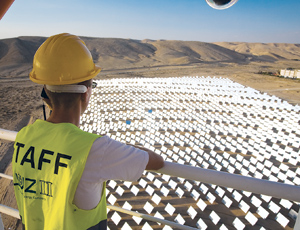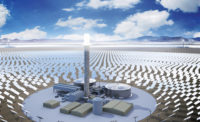California’s push to increase renewable energy’s share of the power market is showing results. Construction of the first phase of a new 400-MW solar power project in the California desert will begin in late 2009 once a contractor is named.

Oakland, Calif.-based BrightSource Energy Inc. this year has signed contracts with Rosemead, Calif.-based Southern California Edison Co. and San Francisco-based Pacific Gas & Electric Co. for a total of 2,200 MW of power from seven planned solar plants at locations in California and Arizona. The five-sq-mile Ivanpah Solar Power Complex in the Mojave Desert near Needles, Calif., will house the first 100-MW tower, which will take 22 months to complete. Six months later the company plans to start a 200-MW tower at the same location and a new one every two years.
Around each 300-ft tower, an array of 50,000 flat heliostat mirror pairs will focus sunlight on a boiler at the top of the tower to heat water in the closed system to 1,100°F steam to power a turbine. By using an air-cooling system, BrightSource plans to limit the amount of water used to 100 acre-ft per year, a 90% decrease from wet-cooled systems.
The announcement follows Israel-based Solel Solar Systems’ 2007 553-MW PG&E contract from a new $2-million parabolic-trough project also planned for the Mojave. Luz International, Solel’s predecessor, successfully demonstrated parabolic-trough technology in the 1980s, with 353.8 MW of “solar electric generating stations” in the area. But very few new installations were built in the U.S. until last June, when Spain-based Acciona Energía S.A. completed Nevada Solar One, a $266-million, 64-MW parabolic-trough system outside Las Vegas. Solel is delaying groundbreaking pending upgrading of transmission lines, which the company expects this year.
A total of 5,000 MW of concentrating solar facilities is now on the drawing board nationally, according to Cara Libby, project manager for Palo Alto, Calif.-based Electric Power Research Institute.
The California Public Utilities Commission requires utilities to supply 20% of power delivered from renewable sources by 2010. In 2007, the state’s three investor-owned utilities supplied 12.7% of retail sales from renewables, but many analysts think they will fall short. The next goal is 33% by 2020. Concentrating solar power (CSP) could play a part in meeting that requirement if it is competitive with other renewables. “We look at price, viability and financing before contracting with a company,” says Jonathan Marshall, PG&E spokesman.
CSP still faces challenges, according to Libby. It is still mainly a peak resource without advances in thermal storage. The cost per kilowatt leaving the plant is 12.6¢, compared to coal at 10.6¢, according to a 2008 estimate by the California Energy Commission.
Some projects face more roadblocks than others. On April 15, San Francisco-based GreenVolts Inc., which signed a 20-year contract in 2007 with PG&E, announced an indefinite delay in construction of its 2-MW concentrating photovoltaic system in Byron, Calif.
The 10-acre GV1 site 100 miles outside San Francisco was planned as a two-axis low-profile tracker to position a reflective mirror and refractive optical element combination to concentrate sunlight by 625 times onto gallium arsenide-based triple-junction photovoltaic cells. A GreenVolts spokesman declines to talk about price or when construction would resume, but says the company plans to have the pilot project operational in 2010.




Post a comment to this article
Report Abusive Comment